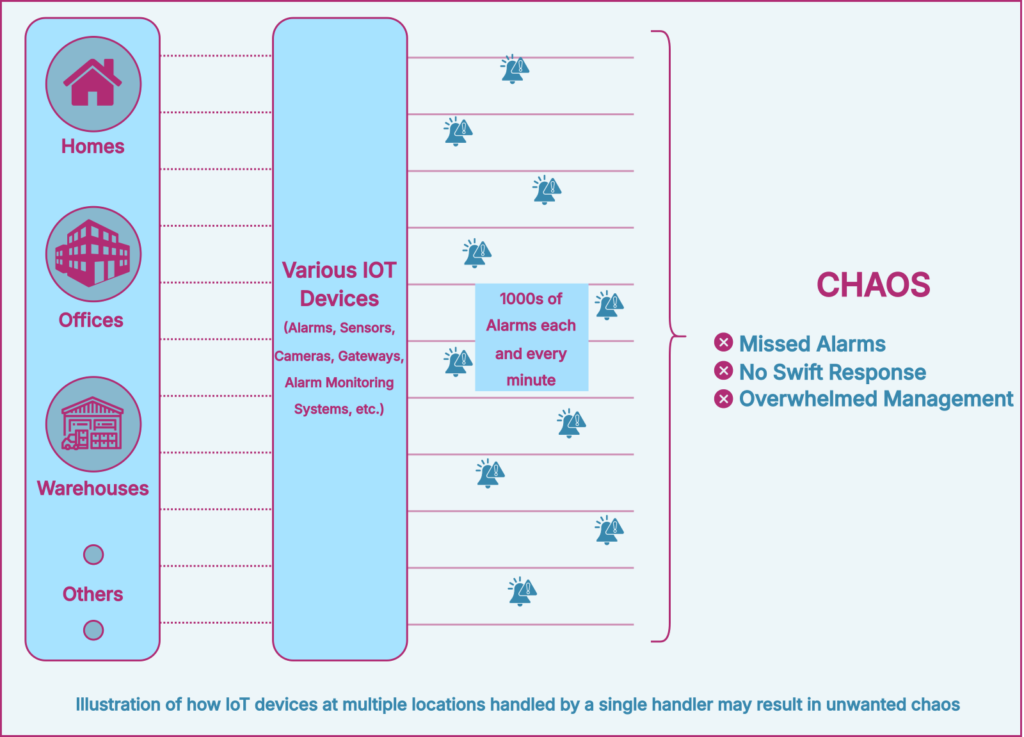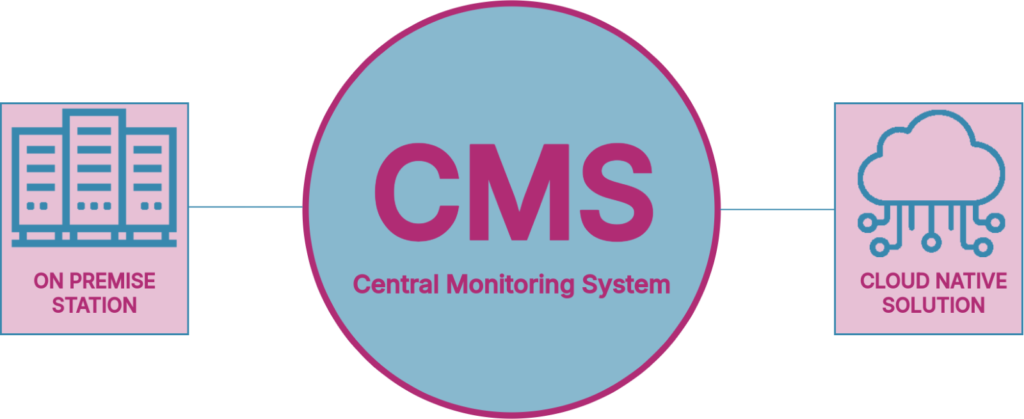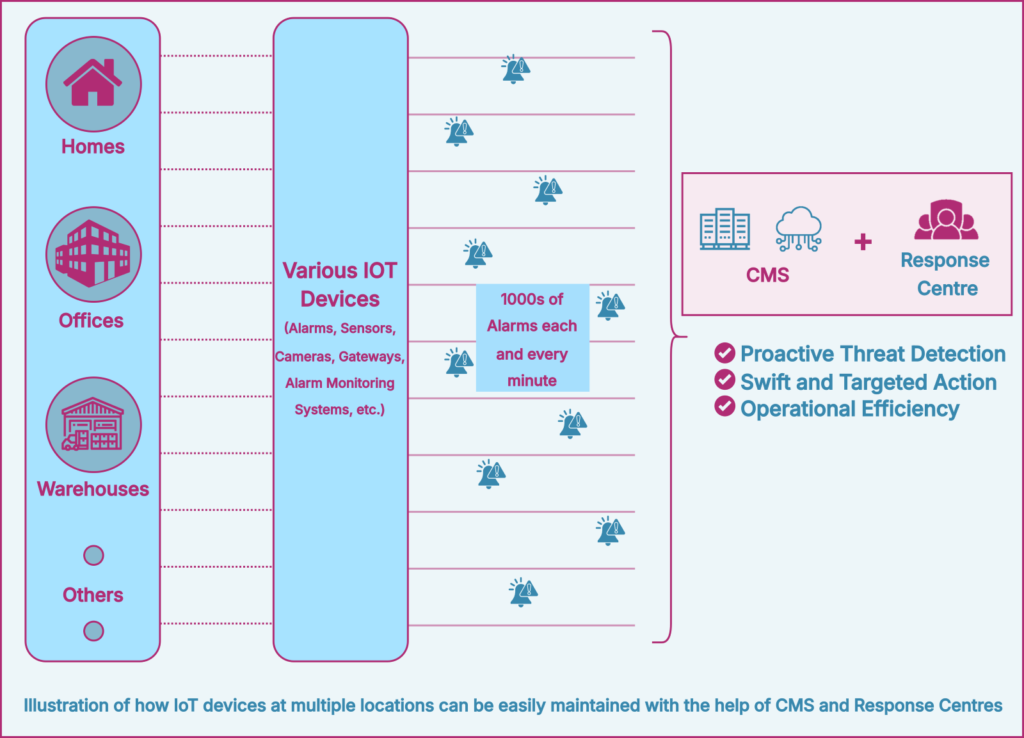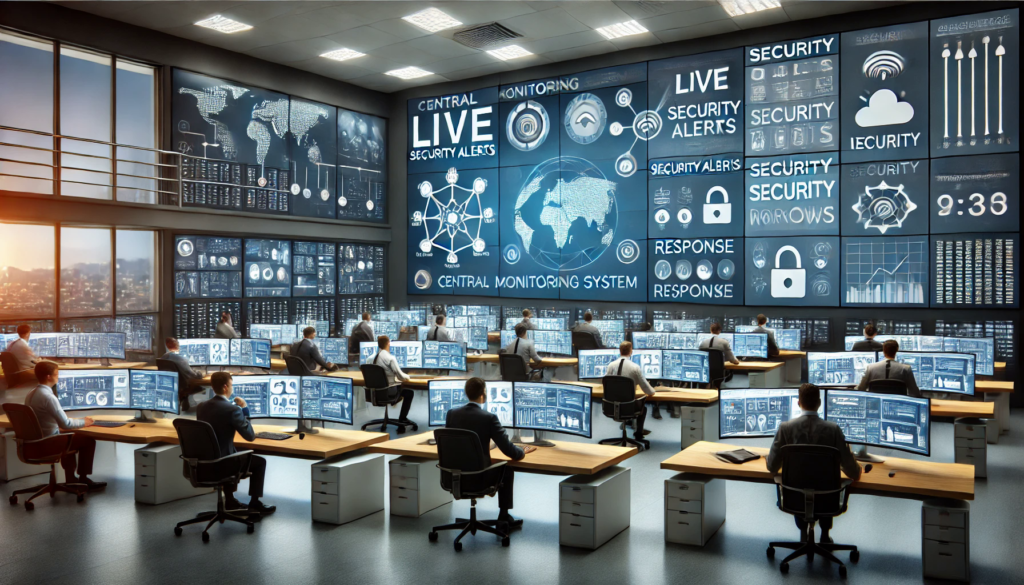In today’s fast-evolving IoT security landscape, managing multiple systems can quickly become overwhelming. The flood of alerts, notifications, and alarms generated across various devices or properties demands not just efficient handling but also timely responses to ensure real-time security.
Central Monitoring Systems (CMS) and Response Centers effectively address these challenges by streamlining management and enabling swift responses.
Addressing the Overload of IoT Security Alerts
Addressing the Overload of IoT Security Alerts
IoT-based security systems excel in their ability to connect and respond in real time, offering a wide range of monitoring capabilities from fire alarms to smart devices like crash detectors or personal emergency systems. However, the sheer volume of data from multiple devices and locations can result in overwhelming alert overload, false alarms, and inefficient response times.

Let’s dive deeper into the essential details of CMS and Response Centres in the following sections.
Central Monitoring Systems (CMS)
A Central Monitoring System (CMS) functions as a unified platform that manages security data from various IoT devices, including fire alarms, intrusion sensors, and even smart devices like cars or wearables. In some cases, homes or properties may also have an Alarm Monitoring System (AMS) or a hub, acting as the first layer gateway for data collection at the customer's premises. This AMS collects and processes data from local security systems before sending it to the CMS for centralized monitoring.
By acting as the first layer, the AMS filters initial alerts and ensures only relevant data is forwarded to the CMS, streamlining the process. The CMS then manages the data flow from multiple properties or devices, prioritizing alarms and automating responses.
CMS providers can deploy systems in two configurations:
On-Premise Solutions: Installed locally on dedicated servers, offering full control but requiring significant investment in hardware, maintenance, and scalability.
Cloud-Native Solutions: Hosted on cloud platforms, providing scalability and lower infrastructure costs but potentially introducing latency and security concerns.

Both setups offer real-time monitoring, intelligent filtering, and automated responses, with the end user experiencing almost similar seamless functionality.
Key Features of an Ideal CMS
An effective CMS integrates infrastructure, automation, and robust management tools, offering real-time monitoring and response for IoT security systems. Here's a prioritized breakdown:
Infrastructure:
CMS can be deployed on-premise with dedicated servers, databases (e.g., SQL, NoSQL), or via cloud platforms (AWS, Azure, Google Cloud) for scalability and reduced maintenance. Cloud services use containerization (Docker, Kubernetes).

Alarm Management:
Alarms are processed in real-time using systems like Apache Kafka or RabbitMQ. AI models (TensorFlow, Scikit-learn) escalate critical events based on predefined rules..

Team and Operational Management:
On-premise systems use tools like Nagios for health checks. Cloud CMS relies on managed services (AWS CloudWatch, Azure Monitor) for centralized monitoring.

Automation:
Automation is powered by rules engines (Camunda, Drools) and event-driven architecture (Kafka, AWS Lambda), optimizing response times with auto-dialers and notifications (Twilio, SendGrid).

Seamless Integration with IoT Devices and Security Service Providers:
CMS integrates with IoT devices (fire alarms, smart cameras) via protocols like MQTT, REST APIs, and WebSockets. It connects with security providers for coordinated alarm and incident management.

White-Label Support:
CMS providers offer customizable dashboards and APIs for white-label solutions, supporting multiple brands through multi-tenant architecture.

Apps for all Stakeholders:
Mobile apps (React Native, Flutter) and web interfaces (Angular, React) provide control for response teams and end users, with push notifications via Firebase or OneSignal.

Redundancy and Failover:
On-premise solutions use RAID storage and dual servers for redundancy. Cloud CMS uses auto-scaling and geographic redundancy to ensure high availability.
Management Software:
CMS integrates with management tools (ServiceNow, PagerDuty) for alarm prioritization, incident tracking, and ticketing (Jira, Zendesk).

Scalability:
Cloud CMS uses auto-scaling (AWS EC2, Google Cloud Autoscaler) and serverless architecture (AWS Lambda). On-premise systems scale with additional servers or distributed databases.

Compliance:
CMS must comply with security standards (ISO 27001, POPIA, GDPR) to ensure data protection and privacy.

Key Specialized Services for Enhanced Security
There are countless specialized services a CMS can offer, but here are some of the most critical ones:
- Extensive 24/7 Video Monitoring of various devices
- 24/7 Two-Way Voice Communication Support
- Real-Time Data Analytics using AI
- Geo-Location Tracking for Response Teams
- Automated Incident Reporting and Management
- Remote Device Management
These services are just a glimpse of the capabilities a CMS can offer, providing a tailored solution for diverse security needs.
The Role of Response Centers

While CMS excels in detecting and prioritizing threats, the actual resolution often depends on response teams. Response centers are specialized units that act on alerts generated by the CMS, providing on-ground support when required.
Why Dedicated Response Centers Matter
- Faster Response Times: Unlike relying on local authorities, private response teams can act immediately, reducing the risk of escalation.
- Reduced Strain on Authorities: Frequent false alarms can waste valuable police resources, but response centers mitigate this by handling incidents directly.
- Tailored Action Plans: Response teams work according to pre-defined protocols suited to specific companies or properties.
Some CMS providers integrate response centers as part of their service, creating an all-in-one security ecosystem. Others may partner with third-party teams to offer these services.
How CMS and Response Centers Solve the Problem
When combined, CMS and response centres form a comprehensive security solution. Together, they address the challenges of IoT security in the following ways:
- Proactive Threat Detection: CMS detects and prioritizes threats, focusing on high-priority issues.
- Swift and Targeted Action: Response teams are dispatched immediately, removing delays from manual intervention.
- Operational Efficiency: Automation and streamlined workflows reduce burdens on security companies and property managers, allowing focus on core tasks.

The Impact: A Safer, Smarter Future
For Property Managers and Security Dealers:
- Cost Savings: Outsourcing eliminates in-house infrastructure needs.
- Brand Identity: White-label services maintain company branding.
For End Users:
- Peace of Mind: 24/7 monitoring and rapid response ensure safety.
- Reduced False Alarms: Automated verification minimizes unnecessary alerts.
For Society:
- Efficient Resource Utilization: Reduces strain on public services for critical emergencies.
- Advanced Safety Standards: Adherence to global security standards ensures data protection.
Final Thoughts
The world of IoT-based security is evolving rapidly, and with it comes both opportunity and complexity. Central Monitoring Systems and response centers are paving the way for a smarter, more efficient approach to security. By addressing the challenges of alert overload, false alarms, and delayed responses, these solutions ensure that no threat goes unnoticed and no action is delayed.
As we look toward a future where connected devices play an even greater role in our lives, investing in CMS and response centers isn’t just a choice—it’s a necessity. Together, they form a seamless, reliable, and intelligent security ecosystem that keeps us safe in an increasingly interconnected world.

